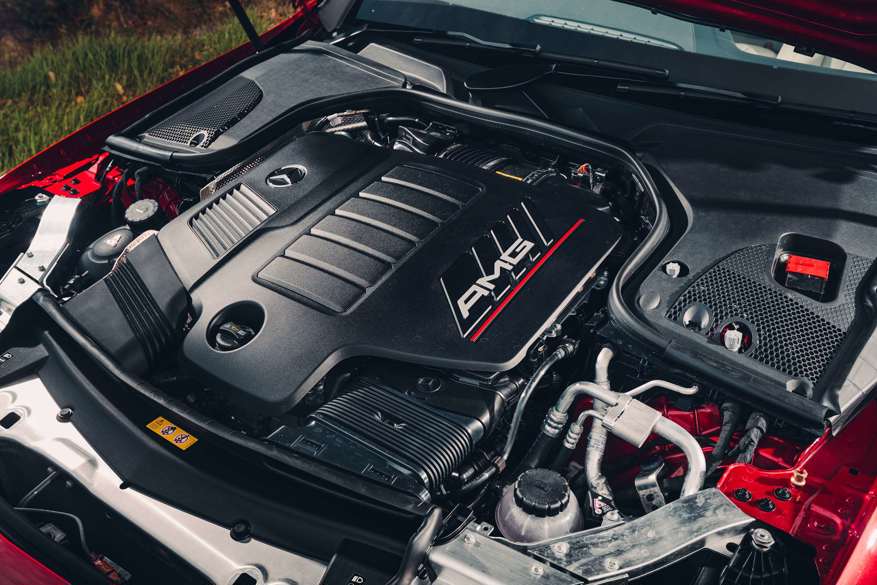
Mercedes EQ Boost Explained: How the M256 Inline-6 Works, Why It’s Fast, and How to Unlock More Power
The Mercedes-Benz EQ Boost powertrain pairs a 48V Integrated Starter-Generator (ISG) with the M256 inline-six. Stock, it’s smooth and refined. Tuned, it becomes sharper—instant throttle response, harder midrange, and a powerband that feels almost supercharged. If you’re considering EQ Boost tuning, here’s how it works and how a calibrated M256 ECU tune plus M256 performance downpipes can safely unlock real horsepower and torque without sacrificing Mercedes refinement.
What Is Mercedes EQ Boost?
EQ Boost is Mercedes-Benz’s 48-volt mild-hybrid system that pairs a compact lithium-ion battery with an Integrated Starter-Generator (ISG). Instead of a traditional belt-driven starter/alternator, the ISG sits between the engine and transmission to enable seamless start/stop, regenerative braking, and—most importantly—instant electric torque fill while the turbocharger spools.
- Electric Torque Assist: Low-RPM shove that kills lag and cleans up tip-in.
- Energy Recovery: Recaptures energy under braking/coasting for the 48V battery.
- Accessory Drive: Electric A/C and water pump reduce parasitic losses.
- Refined Start/Stop: Faster, smoother restarts at lights—no shake, no drama.
How the M256 Inline-6 & ISG Work Together
The M256 3.0L inline-six uses a twin-scroll turbo and electronically controlled auxiliaries. The ISG adds torque the moment you touch the throttle (up to a substantial assist), then hands off to the turbo as boost builds. The result is a powerband that feels linear and responsive with fewer flat spots than typical turbo engines.
Factory calibration is conservative: torque targets, boost ramps, and torque modeling are set for comfort and emissions first. With a smarter map, the turbo is allowed to build sooner, while the ISG torque-fill is timed to carry you through that early window—so you get continuous thrust instead of a step change.
Because accessories are electrically driven, the engine prioritizes combustion efficiency and boost response instead of spinning belts. That’s why M256 EQ Boost cars feel lively in daily driving yet remain quiet and refined on the highway.
Real-World Benefits on the Street
- Immediate throttle response: ISG torque masks turbo lag—clean launches, crisp mid-corner pickups.
- Smoother power delivery: Linear pull through the midrange; no dead spots.
- Better efficiency: 48V system reduces parasitic losses and smooths start/stop.
- Daily-drivable refinement: Quieter, cleaner starts; effortless cruising on long drives.
What it feels like: press the pedal, the car moves now—then builds into a steady shove that doesn’t fade until you lift. It’s confident, not frantic.
ECU Tuning: Safe Gains with EQ Boost Harmony
EQ Boost tuning focuses on the combustion side: a quality M256 ECU calibration refines boost control, fueling, and timing within safe limits while keeping OEM safeguards intact. We also respect the torque model and gearbox limits, so added power translates to clean, repeatable performance.
- Tune Only: ~450+ HP / ~500+ lb-ft (fuel-dependent)
- With supporting mods: ~530+ HP / ~600+ lb-ft
- 91/93/98/100 octane maps: Calibrated for your fuel and climate.
- Burble options (AMG): Adjustable overrun with OEM protections left on.
On-road difference: earlier boost onset, stronger midrange, lower throttle angle for the same pace, and a calmer right foot on the highway.
Downpipes: Faster Spool, Lower Backpressure
Factory catalytic downpipes are restrictive. M256 performance downpipes reduce backpressure so the turbo spools faster and the engine breathes easier. Paired with the tune, you get faster transient response, more headroom, and a deeper note that fits the car’s character.
- Quicker boost rise: Stronger midrange punch and cleaner gear-to-gear pulls.
- More power headroom: Freer-flowing exhaust for tuned setups.
- Sound: A richer, more assertive exhaust tone—especially noticeable on AMG 53 models.
Note: Confirm local emissions regulations and intended use. Professional installation recommended.
Supported EQ Boost Models (M256)
- E53 AMG (2019–2025)
- CLS53 AMG (2019–2025)
- AMG GT 53 (2020–2025)
- GLE53 AMG (2020–2025)
- GLS53 AMG (2021–2025)
- E450 (2019–2023)
- CLS450 (2019–2023)
- S450 (2018–2020)
- GLE450 (2020–2025)
- GLS450 (2020–2025)
EQ Boost FAQ
Does EQ Boost replace the turbo?
No. EQ Boost adds electric torque and efficiency; the turbo still provides the majority of power once spooled.
Will ECU tuning affect EQ Boost reliability?
Our calibration keeps OEM safety strategies active and maps cleanly with ISG torque fill. Use quality fuel and follow maintenance intervals.
Do I need downpipes to tune my M256?
No, but downpipes significantly reduce backpressure and improve response—ideal if you want maximum gains with the tune.
Will my ECU need a bench unlock?
Some early M256 ECUs (MG1/MD1) require a bench unlock before flashing. We provide a fast bench/unlock service when needed.